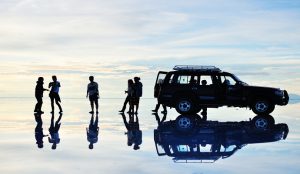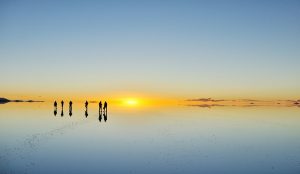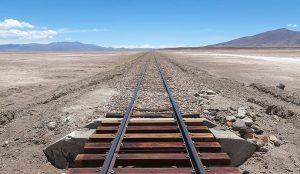 Print Itinerary
Print Itinerary
Inclusions:
- Entrance fees
- Accommodation
- Meals as informed
- Private transport (4 x 4 vehicles)
Daily departures available
Day 1 UYUNI – MALLKU (B – L – D)
In the morning, we depart from the city of Uyuni towards the town of Mallku. Our first stop will be at the Train Cemetery where you can see the remains of 19th and early 20th century steam locomotives. Then we continue our drive south, to the historical town of San Cristobal, a place well known for its silver mining activities, and still currently running. Then we continue our drive through the high Andean plateaus. On the way, and with some luck, perhaps we will be able to see the Andean Ostrich (locally known as Suri or Ñandu de los Andes). We will also stop at the Waterfall Canyon and later on, we will stop for a visit to the place known as “Valle de Rocas” (Stone Valley), an interesting geological formation. Finally, we will arrive to the small town of Mallku Villamar where we will overnight in a local small hotel (with the more comfortable option we overnight in Mallku Cueva Lodge).
Day 2 MALLKU – LAGUNA COLORADA (B – L – D)
This day we drive southwest towards the Eduardo Abaroa National Park. Our drive will take us through the bofedales, a green oasis in the middle of the desert where we can observe llamas and birds. We also can get clear views of the Uturunco Volcano (6,020m). We will pass the Salar de Corina where we can observe the Ulexita fields (borax). Continuing our drive, we will arrive at the shores of the beautiful Laguna Colorada, a lagoon lying at an altitude of 4,350 metres, and covers an area of 60 km2. The rich red colouration comes from algae and plankton, and the shoreline show brilliant white deposits of sodium, magnesium, borax and gypsum. Numerous flamingos, three species of which breed there, inhabit the lagoon: The Chilean flamingo (Phoenicopterus Chilensis), the James flamingo (Phoenicopterus James) which is the smallest of the three species, and the Andean flamingo (Phoenicopterus Andinus), the largest of the three. To see these pink friends strutting through icy mineral lagoons at 5000m will make you abandon timeworn associations between flamingos, coconut palms and hot steamy tropics. From Laguna Colorada we go up to 5000 metres and then we continue south to the place known as “Sol de Mañana” (Morning Sun) where at about 4,800 metres lays a geyser basin with bubbling mud pots, hellish fumaroles, and a thick aroma of sulphur fumes. This is a site of intense volcanic activity where inside small craters we shall observe boiling lava, reminding us of the age in which the earth was formed. Then we descend to the Salar de Chalviri connected with the Thermals of Polques (hot springs). We cross along the Dali Valley, a desert covered by strange stone formations, surrounded by a colourful volcanic area, and we continue on our way to the base of the high steep Licancahur Volcano where we find the Laguna Verde and Laguna Blanca. We will enjoy the wonderful view of this landscape, and then we return to Laguna Colorada for overnight in a small simple hotel (or we continue to Ojitos de Perdiz for overnight in the Tayka Hotel del Desierto).
Day 3 LAGUNA COLORADA – VILLA CANDELARIA (B – L – D)
Early in the morning, we start our drive north towards the small town of Villa Candelaria (or to San Pedro de Quemez for the Hotel Tayka de Piedra). Our first stop will be at the Arbol de Piedra (Tree of Stone) located in the Siloli desert. Continuing our drive, we will pass the lagoons known as Ramaditas, Hona, Chiarjota, Hedionda and Cañapa. In all these lagoons, we will find flamingos and other interesting Andean birds, and with luck, perhaps we can observe the flight of the Condor. Later on we will see the active Ollague Volcan (5,865m), and then we will cross the Salar de Chiguana before we arrive to Villa Candelaria for overnight in a small simple hotel (or we arrive to San Pedro de Quemez for the hotel Tayka de Piedra). On the way to our hotel, we shall visit Ikala (Pueblo Refugio). In 1879, during the Pacific war, the Chilean military invaded Bolivia, entering what is now the cantons Pajancha and Kana in the municipality of San Pedro de Quemes. Arriving at the village of San Pedro the military burned all the houses making the people who survived the tragedy to move to a corner of the township, to the place now known as Ikala. After several years, and due to the lack of water in Ikala, people decided to return to the town of San Pedro to rebuild homes, and then decided to change the name of the town to San Pedro de Quemes, located on a slope of the old town. The area is beautiful and scenic and offers several opportunities to enjoy lovely hikes. Then we continue to San Pedro de Quemes for overnight in the Tayka Hotel de Piedra or continue to Villa Candelaria for lodging in a small simple hotel.
Day 4 VILLA CANDELARIA – SALAR DE UYUNI – UYUNI (B – L)
In the morning, we start our drive towards the amazing Salar de Uyuni. Our first visit will be to the Galaxy cave, a dried sub aqueous cavern, formed before the ice age, corresponding to volcanic eruptions in waters of Minchin Lake. From the ceiling of the cavern, it displays calcareous bodies with capricious forms of solidification of the magma in contact with the water. Then we continue our drive towards Isla Pescado (Fish Island) a rocky hill covered in trichocerus cacti and a flat, white sea of hexagonal salt tiles. A large population of viscachas (Andean rodents) inhabits its rocky slopes, which also afford views of the flat region that are reminiscent of the Polar region, dominated by the blue and white colours. Fish Island is an oasis with a unique and isolated ecosystem. From here, we continue towards Incahuasi Island, another interesting hilly outcrop situated in the centre of the Salar and with rock formations containing the remains of corals and seashells. The island has species of cactus that grows up to 7m tall, at a rate of 1 centimetre per year, making them up to 700 years old. Here we take a hike up to the summit of the hill from where we have an extraordinary view of the surreal Salar de Uyuni. After lunch, we will continue our drive towards the small village of Colchani, which lies beside the Salar de Uyuni and is home to the Cooperative Rosario – the main plant for the iodisation of salt. After visiting the artisanal salt factory, we make our final drive to Uyuni. Transfer to your hotel (not included).
End of our Services
Food Code = B – Breakfast, L – Lunch, D – Dinner.
LHEABOL001 *Please note, prices based on twin share, per person. Minimum: 2 participants. Basic accommodation and private services. In case you have a larger group, prices will be re-calculated accordingly. The itinerary & pricing can change at any time due to availability & of activities. Please check our website for full terms and conditions*
More Information on Bolivia:
Bolivia – officially known as the Plurinational State of Bolivia is a landlocked country located in central South America. It is bordered by Brazil to the north and east, Paraguay and Argentina to the South, Chile to the southwest, and Peru to the west. Prior to European colonization, the Andean region of Bolivia was a part of the Inca Empire – the largest state in Pre-Colombian America.
More Information on the visited place:
Uyuni Salt Flats (Salar de Uyuni) – an area of breathtaking natural beauty in south western Bolivia.
The Salar de Uyuni covers nearly 11,000 square kilometers, it is the largest salt plain in the world. With the mountains and the sky as its only frontiers, it allows us to observe mirages and optical illusions due to solar radiation and the crystallized ground. In its interior, virgin, uninhabited islands are home to a species of immense cactus with unusual flowers. A succession of stunning landscapes and unusual shapes that captivate the visitor at first sight.
Visa Requirements for Bolivia:
Visa is not required for Australian Citizens for a stay of maximum 30 days.
For more information contact your nearest Bolivian Consulate or Embassy




